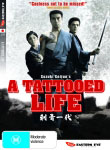Tattooed Life, A (Irezumi Ichidai) (1965) |
|
Tattooed Life, A (Irezumi Ichidai) (1965) |
|


|
| BUY IT |
| General | Extras | ||
| Category | Crime |
Gallery-Photo Trailer-Madman Trailers |
|
| Rating |

|
||
| Year Of Production | 1965 | ||
| Running Time | 83:08 | ||
| RSDL / Flipper | Dual Layered | Cast & Crew | |
| Start Up | Menu | ||
| Region Coding | 4 | Directed By | Seijun Suzuki |
|
Studio
Distributor |
Nikkatsu Madman Entertainment |
Starring |
Hideki Takahashi Akira Yamauchi Hiroko Itô Masako Izumi Kayo Matsuo Hôsei Komatsu Yuji Odaka Michio Hino |
| Case | Amaray-Transparent | ||
| RPI | $24.95 | Music | Masayoshi Ikeda |
| Video | Audio | ||
| Pan & Scan/Full Frame | None | Japanese Dolby Digital 2.0 mono (224Kb/s) | |
| Widescreen Aspect Ratio | 2.35:1 | ||
| 16x9 Enhancement |
 |
||
| Video Format | 576i (PAL) | ||
| Original Aspect Ratio | 2.35:1 | Miscellaneous | |
| Jacket Pictures | No | ||
| Subtitles | English | Smoking | Yes |
| Annoying Product Placement | No | ||
| Action In or After Credits | No | ||
Japan 1926. Tetsu (Hideki Takahashi) is a yakuza killer for hire, using the money he earns to put his gentle brother Kenji (Kotobuki Mananomoto) through an arts course. Tetsu fulfils a contract killing for the Owada family but they decide they want Tetsu dead. He is only saved by the arrival of Kenji but an Owada yakuza is killed in the process and so the brothers decide to flee Japan and head for Manchuria. In a seaside town they try to find a ship but are swindled of their money. Stranded, they hide from the police, finding work with a crew building a tunnel for the construction company headed by honest Yuzo Yamashita (Akira Yamauchi). The brother’s chances of remaining unnoticed and out of trouble, however, are not helped by the fact that Kenji becomes obsessed with Yamashita’s wife, Masayo (Hiroko Ito), while her sister Midori (Masoko Izumi) falls in love with Tetsu although she is promised to Yamashita’s manager Ezaki (Yuji Odaka). Something is bound to give.
When the rival Kanbe construction company sabotages the Yamashita tunnel, Tetsu is blamed and his real identity revealed. Yamashita is also told about the relationship between his wife and Kenji, Kanbe and the Owada family joining to use this information to pressure Yamashita into signing a crooked construction contract. When he refuses, Masayo is kidnapped bringing Kenji into the picture. Tetsu sets out to rescue them and the stage is set for a final explosive, bloody confrontation.
Between 1956 and 1967 Seijun Suzuki directed over 40 films for Nikkatsu Studios, a studio known for its formulaic yakuza and soft core sex films. Tiring of the formula, in 1963 Suzuki made Youth of the Beast, introducing the flamboyant colours, oddball characters and striking compositions for which he would become famous, an approach further refined in A Tattooed Life. Nikkatsu were not happy with his non-formulaic approach, and were less pleased when Suzuki followed up with the psychedelic, surreal Tokyo Drifter in 1966 (a fabulous film), and the film noirish Branded To Kill (1967). Nikkatsu bosses then decided that they had had enough of Suzuki and he was both fired and blacklisted for 10 years, only able to get TV work.
A Tattooed Life (Irezumi ichidai), also known as White Tiger Tattoo, The Life of a Tattooed Man or One Generation of Tattoos, is a good, entertaining B grade yakuza film for most of its short running time. It has interesting, quirky supporting characters, such as the swindler Senkichi, dynamite man Seikoh, bar girl Oyuki and construction foreman Tsune, although such is the short running time that they are underdeveloped. The leads, especially Hideki Takahashi and Masoko Izumi, are very good and the film builds up a nice tension and provides some good looking sets, such as the construction site. In short, A Tattooed Life is interesting and entertaining enough - until the final sequences in the rain where things change exponentially!
Nothing in the film prepares you for the amazing climax. Before that time colours had been muted and flat; now suddenly psychedelic colours occur – reds, blues, yellows, not to mention whites (I know it is not a colour as such, but here it is used as one) that heighten the intensity of the climax in and around a maze of rooms and various coloured screens. Previously, the couple of scenes of violence had been quite pedestrian; now we get a stylised ballet in long takes with swords and guns that is quite exhilarating. And finally, the climax includes some amazing camera angles, including one sequence shot from below the actors. This climax is truly invigorating stuff.
The word most often applied to Suzuki is “cool”. Not surprisingly, Tarantino is a fan and Suzuki certainly has a style all his own. While most of A Tattooed Life is interesting enough, it is the climax in the rain with its stylish action, psychedelic colours and amazing camera angles that gives us the opportunity to witness Suzuki’s developing style, and to see for ourselves what the fuss is all about. If you have any interest in this genre, make sure you take a look at A Tattooed Life.
A Tattooed Life is presented in an aspect ratio of 2.35:1, the original theatrical ratio, and is 16x9 enhanced.
In the main it is a soft print, lacking contrast and clarity although brightness is mostly consistent. The film also has dull, flat colours, and while skin tones look OK if on the pale side, shadow detail is lacking. Blacks are barely adequate, with many scenes showing a bluish tone. The climax turns this around somewhat, where the vibrancy of the reds, blues, yellows and whites is excellent. In truth it is not a great print although it is never unwatchable.
There is some aliasing evident, and both positive and negative artefacts are frequent, some quite noticeable (such as at 11:97) although none are distracting for any length of time.
The English subtitles are in a yellow font. I noticed no obvious spelling or grammatical errors, except for US spelling. Japanese signs are translated in a white text, however they flash up so fast that you cannot read them without pausing the film. The one at 6:24 flashes by so fast you have no chance to read it, even frame by frame, while one at 30:50 actually reads “Yamashita Family – Aone Tunnel Construction Site No. 2”. Good luck to all speed readers!
| Sharpness | |
| Shadow Detail | |
| Colour | |
| Grain/Pixelization | |
| Film-To-Video Artefacts | |
| Film Artefacts | |
| Overall |
Audio is a Japanese Dolby Digital 2.0 mono at 224 Kbps. It is a subdued track and in fact I needed to turn up my volume quite a bit. Dialogue is clear enough, but the effects were very flat and dull, even the explosions and gunshots. There was no surround or subwoofer use.
The music by Masayoshi Ikeda supported the film well without being memorable.
Lip synchronisation was occasionally off.
| Dialogue | |
| Audio Sync | |
| Clicks/Pops/Dropouts | |
| Surround Channel Use | |
| Subwoofer | |
| Overall |
The inside cover of the DVD includes information about the life and films of director Suzuki Seijun and is quite informative. The same information is repeated in other Madman releases of Suzuki Seijun’s films such as Tokyo Drifter.
5 black and white movie stills. Silent, use the remote to advance.
Trailers for other films from Madman: The Host (2:15), Tokyo Drifter (1:10) and Branded to Kill (0:45).
NOTE: To view non-R4 releases, your equipment needs to be multi-zone compatible and usually also NTSC compatible.
The Region 1 US version has similar video and audio specifications, with only cast and crew information and a director filmography as extras. I cannot find a record of a Region 2 UK version. There is really no reason to go beyond our Region 4 release.
In 1967 director Seijun Suzuki was fired from Nikkatsu Studios, and blacklisted for 10 years. Suzuki has a style all his own and in the climax of A Tattooed Life, with its stylish action, psychedelic colours and amazing camera angles, we have an opportunity to witness his developing style, and see for ourselves what the fuss was all about.
The DVD has adequate video and audio and minimal extras but there is no better release in any other region.
| Video | |
| Audio | |
| Extras | |
| Plot | |
| Overall |
| Review Equipment | |
| DVD | Sony BDP-S350, using HDMI output |
| Display | LG 42inch Hi-Def LCD. This display device has not been calibrated. This display device is 16x9 capable. This display device has a maximum native resolution of 1080p. |
| Audio Decoder | NAD T737. This audio decoder/receiver has not been calibrated. |
| Amplification | NAD T737 |
| Speakers | Studio Acoustics 5.1 |